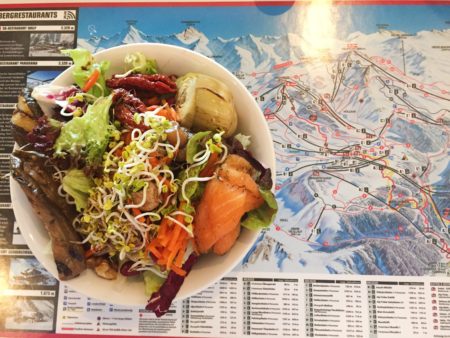Traveling with dietary restrictions has the potential to be intimidating and at times can seem next to impossible. My husband and I travel a lot so when I went fully dairy, sugar and gluten-free in April of last year, I was anxious about how I would handle travel, especially outside of the U.S. In the past, I had made exceptions, but I was feeling so good I didn’t want to go backwards. Besides, I know that consistency is key in dietary and lifestyle changes and making those exceptions always put me off track. I wanted to stay on track long-term.
I wanted to stay on track long-term.
Luckily, I’ve been able to successfully navigate traveling with dietary restrictions to some of the most dairy and gluten-laden countries – Italy, Greece, Austria and Switzerland, to name a few.
While it hasn’t always been easy, my commitment to my health and well-being regardless of where I am or what I’m doing has paid off.
First, I never feel bloated and in need of a “diet” “cleanse” or “reset” after a vacation. I have been able to maintain my healthy weight while traveling, which is something I used to struggle with, my jet lag is always more manageable and most importantly, I never feel deprived or have food FOMO (fear of missing out).
These are some of my tried and true tips for how I’ve navigated traveling with dietary restrictions:
Before I get into them, though, I want to preface that my restrictions are based on preferences, healthy lifestyle choices and mild insensitivities. This is not a how-to for someone who has life-threatening dietary restrictions. I fully acknowledge it may not be this accessible to eat safely with true allergies.
One// Eat local. Think of the local cuisine and foods that are customary in the country to which you’re traveling. It would be easy to get sucked into the pasta and orzo in Italy and Greece, but I focused on eating a Mediterranean diet – lots of fresh seafood, vegetables and olives – all of which are abundant in the region.
Two // Do your research. Assuming you know which hotels or resorts you’ll be staying at and restaurants you’ll visit, do some research to ease your mind that you’ll be able to find something to suit your needs. When we were planning a trip to Italy last Summer, I was pleasantly surprised to find that many restaurants offered gluten-free pasta options. My further research revealed that a sizable percentage of the population of Italy has celiac disease, which eased my mind that the term “gluten-free” wouldn’t be misunderstood. Now cheese? Well, that was another issue!
Three // Call ahead. We didn’t have quite the same luck in Austria where meat/schnitzel and cheese are staples. In that case, we emailed/called ahead to the hotel, where we would be having breakfast and dinner almost daily, to inform them of my dietary restrictions and ask if there was anything that could be arranged. They were more than willing to accommodate me and were very gracious. I had the same experience at a restaurant in Switzerland where I was provided a gluten-free bread basket and the waiter walked me through a variety of gluten- and dairy-free options from the menu.
Four // Pack your snacks. If you plan on road-tripping, traveling between countries or taking excursions, don’t assume small delis, cafes or gas stations will have what you need. My husband and I always bring a bag of healthy snacks we can rely on. It’s brimming with nuts, gluten-free crackers, nut butters, fruit and other tote-able, non-perishable items. This has saved me more times than I can count, but especially on the three-hour ferry ride from Mykonos to Santorini in Greece.
Five // Peruse the menu and ask. This is something I do everywhere and it’s especially helpful when there seems to be nothing on the menu that will work. For example, at a restaurant in Austria for lunch, there was a salad with chicken and cheese on it. I saw salmon on the dinner menu, so I simply asked if I could have the salad without chicken or cheese and a piece of grilled salmon instead. The waiter had to ask the kitchen, but they were more than willing to make the substitution and it was so good and satisfying. Likewise, in the ski lodges, I learned quickly that I would have to steer clear of the hot food, but discovered the abundant salad bars, which made for some of the best lunches I had on the mountain. They were also inexpensive which is always a bonus in my husband’s book!
Six // Indulge wisely. I’m not saying you should visit somewhere and not taste the local flavor. You have to decide what that looks like for you. For us, because my husband is also sugar-free, we usually designate one authentic and homemade sweet treat we’d like to have before we leave. In Austria it was apple strudel and in Greece it was baklava. In the UK, it’s a savory option for me – fish and chips. We choose the best place for it and order it one time. If it’s dessert, we typically only have a few bites before it becomes too sweet for us and of course, these items are usually not dairy or gluten-free so I go into it knowing there is a tradeoff and limit the indulgence to one time per trip. I can stand a few bites of gluten with no bad consequences but dairy isn’t always the same story. Again, I just have to know what I’m in for. Once is bearable, repeatedly is a no-go.
Seven // Don’t feel bad. You deserve to eat what you want and what makes you feel like your best self, no matter where you are in the world. Clients often tell me they feel bad or embarrassed for asking, but by no means should you ever feel that way. Ask nicely, never assume anything, be kind and gracious, tip generously and I assure you everything will be fine.
Have you tried any of these strategies? What works or doesn’t work for you when traveling with dietary restrictions?




Leave a Reply